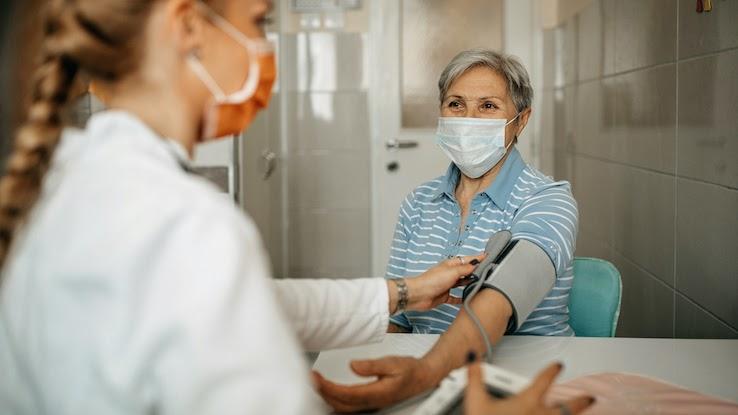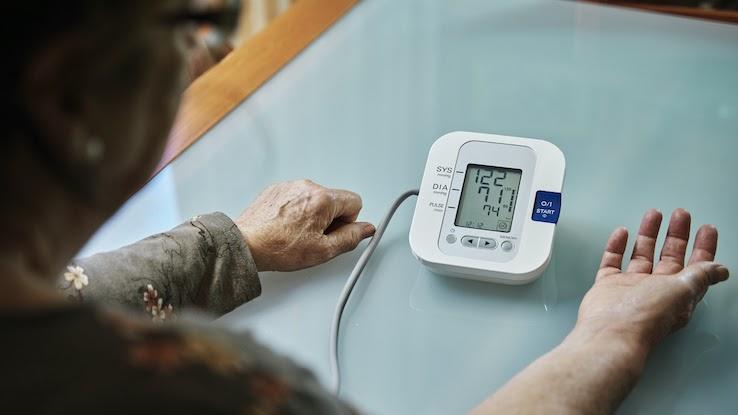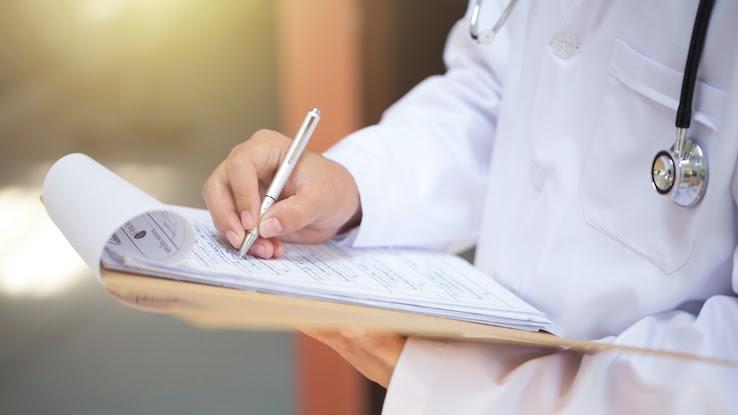Hypertension Basics Guide: Understanding the Symptoms, Diagnosis and Treatments

“Blood pressure” is a medical term that describes how much blood your heart is able to pump and how much resistance your arteries exert while blood is flowing through them. High blood pressure occurs when your heart pumps blood into arteries that have narrowed. Chronic high blood pressure is known as hypertension, and it can have serious, long-term health consequences. Hypertension puts people at risk for strokes, heart attacks, heart failure, aneurysms and other health conditions.
Hypertension affects 108 million people in the United states, and over 75% of them have uncontrolled hypertension — meaning they’re not getting treatment for it — or haven’t successfully lowered their blood pressure back down to within normal limits. This can become a serious issue that impacts all areas of your health. That’s why it’s important to understand what hypertension is and what you can do about it to lead a healthier life after a diagnosis.
Normal Blood Pressure vs. Hypertension

A normal blood pressure reading is 120/80 mmHg (millimeters of mercury). The first number in the reading is systolic pressure; it represents the pressure in your arteries as the blood pumps forward and your heart contracts. The second number is the diastolic pressure, which measures the pressure after your heart contracts and relaxes. In order to be diagnosed with hypertension, you need to have regular blood pressure readings of at least 140/90 mmHg.
It’s important to distinguish between hypertension and high blood pressure. High blood pressure can occur at any point in time for a variety of reasons, including stress, alcohol consumption, diet and fatigue. Usually, high blood pressure is fleeting and your blood pressure reading will return to normal within a relatively short amount of time. Treatment with medications may not be necessary, but a healthcare professional may suggest dietary or exercise lifestyle modifications.
Hypertension, however, is a chronic condition that may have negative outcomes if you leave it untreated. If your provider notices a high blood pressure reading at your annual checkup, they may recommend taking regular readings with an at-home blood pressure monitor. Should your high blood pressure readings persist or get worse, your doctor may consider diagnosing you with hypertension.
The American Heart Association defines Stage 1 hypertension as having regular blood pressure readings of 130/80 mmHg and Stage 2 hypertension as regular readings at or greater than 140/90 mmHg. In order to be diagnosed with hypertension, you must experience chronic high blood pressure for an extended period of time.
Subtypes of Hypertension

Primary and secondary are the most common types of hypertension. They account for the majority of cases. While the cause for secondary hypertension is related to other medical conditions such as kidney dysfunction, thyroid disorders, tumors, sleep apnea and pregnancy, the cause for primary hypertension is unknown.
Primary Hypertension: Primary hypertension is the most common type of hypertension. It’s a complex disorder with no known single cause. Many factors can put you at risk for primary hypertension; these include obesity, diet, environment, stress and a sedentary lifestyle. Eating a high-sodium diet and having a family history of hypertension can also put you at risk for this condition. Even though there’s no single identifiable cause, a variety of factors can trigger primary hypertension.
Secondary Hypertension: With this type of high blood pressure, the cause is apparent and can be an underlying condition such as a thyroid issue. Problems with your kidneys, sleep apnea and some conditions during pregnancy can cause secondary hypertension. In rare cases, this hypertension can be a symptom of an underlying condition such as cancer or organ failure. In some situations, the secondary hypertension will go away when the original symptom is treated. In other cases, it may not be possible to treat the original symptom.
It may not be possible to recognize the cause of your hypertension unless other symptoms are present. Secondary hypertension accounts for a small number of hypertension causes, and without other symptoms, a healthcare professional may not be aware that another condition is causing your symptoms.
White Coat Hypertension: This type of hypertension occurs only when your blood pressure is taken in a clinical setting. Outside of a doctor’s office, your blood pressure is normal, but it becomes elevated likely in response to the stress around visiting a clinic or hospital. If you regularly have high blood pressure readings at medical appointments, you might want to try checking your blood pressure in other locations, such as at your home or a local pharmacy.
Resistant Hypertension: This type of hypertension is unresponsive to strong medications. Hypertension is called resistant if three medications don’t successfully treat the condition. At least four medications may be necessary to treat resistant hypertension.
Symptoms of Hypertension

Hypertension has been referred to as a “silent killer.” People with hypertension may not perceive that their blood pressure is high much of the time. So, they don’t know they need to take preventative measures against strokes, heart attacks and high cholesterol.
Similarly, people may show symptoms of hypertension without showing additional symptoms of an underlying condition. Because the majority of hypertension cases are primary, meaning that there’s no clearly identifiable cause, an underlying condition such as kidney failure or tumors may go unnoticed unless other symptoms are present or unless the patient is required to undergo preventative testing.
Mild to moderate hypertension typically produces minimal symptoms. As hypertension becomes more severe, you may experience the following symptoms:
- Dizziness
- Confusion
- Insomnia
- Irritability
- Headaches
- Blurred vision
- Shortness of breath
- Nausea or vomiting
- Nose bleeds
- Ringing in the ears
- Chest pain
- Seizures
Blood pressure readings of 180/120 mmHg or above are considered what’s called a hypertensive crisis. This is an emergency. If your blood pressure remains at this level after five minutes and retesting, contact your medical provider and seek emergency care immediately. Associated symptoms like chest pain, shortness of breath or numbness can be signs of a heart attack or stroke.
Hypertension Causes and Risk Factors

Hypertension can occur because of a variety of factors, including diet, weight, genetics, stress levels and environmental factors. Your risk may be higher if you’re overweight, if you don’t exercise, if you eat a diet that’s high in fats and salt, or if you’re prone to stress.
There are other risk factors that may increase your likelihood of developing hypertension, too. These include:
- Age. Increased age is associated with a higher risk of high blood pressure. Prior to age 65, men are more likely to develop hypertension. After the age of 65, that increased risk shifts to women.
- Diet choices. A diet heavy in salt and processed foods may lead your body to retain fluids, resulting in an increase in blood pressure and ultimately, a higher risk for chronic high blood pressure.
- Smoking cigarettes or using tobacco products. Smoking cigarettes and using tobacco products can cause an immediate increase in blood pressure. It can also contribute to the narrowing of your blood vessels due to damage that occurs over time.
- Having a close family relative with hypertension. Hypertension is known to have a hereditary component, meaning it runs in families.
- Alcohol intake. Drinking alcohol affects your blood pressure both in the short and long term. It’s important that you drink in moderation to avoid the chronic negative effects of increased alcohol intake. It’s recommended that you have no more than one drink per day if you’re a woman or two drinks per day if you’re a man. A drink is defined as 1.5 ounces of liquor, 5 ounces of wine or 12 ounces of beer.
- Race. African Americans have a higher risk of developing hypertension compared to people of Caucasian descent. In addition, you’re more likely to develop high blood pressure at an earlier age and have more complications from the condition if you’re Black.
- Exercise habits. Living a sedentary lifestyle can cause a higher average resting heart rate, thus forcing your heart to work harder to pump an adequate blood supply. The Centers for Disease Control & Prevention recommend that the average adult gets at least 30 minutes of physical activity five times per week.
- Being pregnant. Parents who are pregnant should seek regular medical attention and have their blood pressure monitored frequently, as hypertension can cause complications for both the pregnant parent and baby. Mortality is a risk for infants with parents who experience hypertension. Some doctors prescribe bed rest to pregnant people who experience hypertension.
- Stress. People who experience high levels of stress are at risk for hypertension-related complications such as strokes and heart attacks. Stress related to work, family and other factors can all cause your symptoms to become more severe. In rare situations, patients who also have sleep apnea may experience disturbances in their sleep. Some hypertension patients experience neurological symptoms.
Screening and Diagnostic Tests for Hypertension

Your provider should measure your blood pressure at each routine appointment, which should occur at least every two years after the age of 18. If you’re above the age of 40 or have a known risk factor for increased blood pressure, you should have your blood pressure checked at least yearly. If you’re unable to see a provider or schedule a yearly appointment, you may be able to check your blood pressure by other means, such as at your neighborhood pharmacy.
An accurate diagnosis of hypertension requires three separate blood pressure measurements that are spaced one week apart. Consistently high blood pressure is indicative of hypertension.
Blood Pressure Test: Medical professionals perform blood pressure tests as part of routine physical exams and office visits. The person measuring your blood pressure will put a cuff on the upper part of your arm. This cuff is operated manually or by a machine. When inflated, this cuff blocks the flow of blood through your arteries. The person measuring your blood pressure can listen to your pulse using a stethoscope in the inner bend of your elbow. This will appear and disappear. Using this technique, it’s possible to gauge systolic pressure and diastolic pressure. Blood pressure monitoring kits can automate this process.
Your doctor should take your blood pressure at least one hour after you’ve had any caffeine and at least one hour after you’ve smoked or exercised. You might be asked to sit or lie down while you’re having your blood pressure measured.
Home Blood Pressure Kits: Home blood pressure monitoring kits are available to measure your blood pressure throughout the day. Many of these kits are portable, so you can see how different activities and situations, such as exercise and work, affect your blood pressure. Your healthcare provider might ask you to keep a log of your blood pressure. Monitoring blood pressure throughout the day at specific times can give healthcare professionals a more accurate representation of how high blood pressure affects you. Your blood pressure patterns may also shed light on whether you have a more serious underlying condition.
Questionnaires: Your medical provider may ask a series of questions about your personal and family medical history during routine physical exams, especially if your blood pressure is high. You may need to fill out a form with your symptoms, personal medical history and family medical history. If the provider notices anything unusual, you may need to explain your symptoms or answer followup questions about your diet, activity levels, experiences with stress and lifestyle.
Physical Exams: Medical professionals recommend that people visit a healthcare professional for a routine physical at least once a year. During this visit, you’ll undergo a comprehensive exam that includes tests and exams to diagnose a variety of conditions.
Your provider may be unable to diagnose your blood pressure based on one office visit. If your blood pressure is high, you may be asked followup questions to determine whether you have a family history of high blood pressure or whether you’re experiencing additional symptoms such as dizziness, fatigue or nausea. Your blood pressure may be mildly, moderately or severely high, and the course of action that your doctor takes will depend on the numbers.
Additional Tests: If you have high blood pressure, a medical provider might prescribe additional tests such as an echocardiogram, urinalysis and ultrasound. These tests can help diagnose additional issues with your heart, kidneys and eyes. These tests can also assess whether your hypertension has caused any significant or permanent organ damage.
Hypertension Prevention and Treatment

Preferred treatment methods for hypertension include lifestyle modifications and medications. First, your medical provider will likely recommend a diet and exercise regimen. If these attempts to manage your symptoms are unsuccessful, your doctor may prescribe you certain medications to help keep your blood pressure under control. The provider will need to monitor your blood pressure regularly and may ask you to monitor your blood pressure through a home testing kit.
Some people are able to effectively prevent hypertension through lifestyle modifications and behavioral changes like:
- Reducing stress through relaxation techniques or environmental changes
- Quitting smoking
- Limiting alcohol use
- Eating a balanced diet and staying hydrated
- Participating in regular aerobic exercise
Maintaining a regular aerobic exercise routine can often improve blood flow enough to lower high blood pressure. As a side benefit, exercise can help improve your mood through the production of endorphins. You will also limit the potential for developing additional complications such as high cholesterol, high blood pressure and diabetes, which all can worsen when you have hypertension.
If you have a family or personal history of hypertension, your doctor might decide to put you on a high blood pressure diet as part of a preventative effort or treatment plan. A high blood pressure diet should be customized for your individual needs. Here are some tips to help plan for a high blood pressure diet:
- Reduce your sodium intake. You should aim to eat less than 2,000mg of sodium in your meals per day. The best way to make this change is by eating out less and cooking your food at home more frequently. This way, you can easily manage the amount of salt that goes into each meal you eat.
- Try the DASH diet. The National Heart, Lung and Blood Institute has found that the DASH (dietary approaches to stop hypertension) diet can help lower blood pressure. This diet includes fruits, vegetables and foods that are low in fat or fat-free.
If diet and lifestyle changes don’t effectively control your high blood pressure, then you may need to take a daily medication to keep your blood pressure under control. Your provider may prescribe one or more of the following medication types:
- Diuretics. Referred to as “water pills,” these medicines help your kidneys reduce fluid and salt levels in your body, which can lower your blood pressure over time.
- ACE inhibitors. These medications work by relaxing your blood vessels.
- ARBs. These medications block a body chemical that naturally narrows blood vessels so pressure on them is reduced.
- Calcium-channel blockers: These work by relaxing your heart muscles and the muscles around your blood vessels while also slowing your heart rate.
In general, it’s important to maintain records of your blood pressure to notice any patterns or increases as you age. If your hypertension is diagnosed early, you can make an effort right away to prevent future complications. For many people, hypertension creates no symptoms until the condition becomes severe. Talk with your healthcare provider if you’re concerned about your blood pressure levels so you can take steps together to manage your cardiovascular health.
Resource Links:
https://www.nhs.uk/conditions/high-blood-pressure-hypertension/
https://www.who.int/news-room/fact-sheets/detail/hypertension
https://www.cdc.gov/bloodpressure/facts.htm
https://www.mayoclinic.org/diseases-conditions/high-blood-pressure/symptoms-causes/syc-20373410





